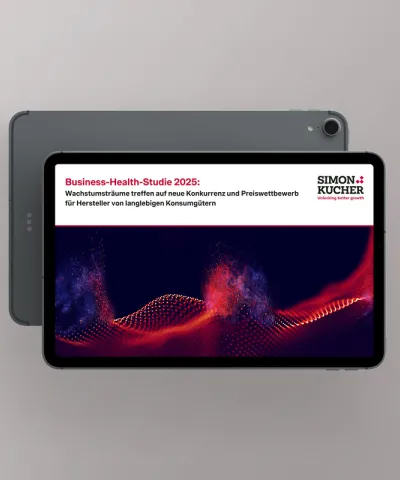Our experts at Simon-Kucher had a front-row seat to the IFA 2024 in Berlin, the global stage for consumer electronics and home appliances. This year’s event showcased a dynamic industry in transformation, driven by cutting-edge advancements and bold strategies.
From the unstoppable rise of Chinese manufacturers to breakthrough AI-powered solutions, the future of the appliance and TV sectors is being redefined before our eyes. Here are the top 10 trends that captured our attention and are set to shape the industry moving forward.
1. Price vs. value: Erosion of the middle segment
How Chinese players are redefining market dynamics
Brands like Haier, Midea, Hisense, and TCL are rapidly gaining market share by offering high-quality products at significantly lower prices compared to established premium players such as Bosch, Samsung, and LG. These emerging brands leverage their competitive manufacturing costs, strong supply chains, and efficient production processes to provide feature-rich appliances and TVs at a fraction of the cost of their Western counterparts. Meanwhile, a strong appetite to expand their brand portfolio through acquisitions is boosting their market presence.
What’s next?
As Chinese and Southeast Asian players continue to dominate markets with affordable yet advanced products, established brands will need to differentiate through product durability, reliability, and brand prestige. Simply competing on price is no longer sufficient. In addition, Chinese brands no longer solely rely on affordability; they are successfully building a high-tech, premium brand image, further threatening the position of creators and leaders of the industry. To remain competitive, traditional brands must focus on providing value-driven innovations.
2. AI-enhanced appliances
Moving from buzzword to tangible use case
LG and Samsung are leading the charge with AI-enhanced ecosystems, setting new standards in automation and personalization across home appliances. While the AI concept is widely used as a selling proposition, it’s important to note that, unlike other trends, the customer experience tied to AI often lacks a concrete, tangible use case that consumers can easily relate to. This has made it difficult for brands to fully demonstrate the practical benefits of AI in everyday life, compared to other innovations.
Benjamin Braun, CMO of Samsung Europe, highlighted Samsung’s strong focus on AI, saying: "This year we aim to have 200 million AI-enabled devices." He emphasized Samsung's ambition to make technology more accessible and sustainable through AI advancements.
What’s next?
The brands that will come out on top are those that can successfully solidify their AI-driven customer experiences into clear, valuable use cases and communicate these benefits effectively to consumers. Predictive maintenance, autonomous operations, and hyper-personalization will continue to be important, but the real differentiator will be a company’s ability to translate these features into real-life, relatable experiences. Companies capable of creating comprehensive AI ecosystems across multiple devices will lead, but only if they can demonstrate how these features tangibly improve daily life. In this sense, AI needs to evolve from a buzzword to a customer-centric solution to truly impact the market.
3. Next-gen display
Bringing immersive visuals to everyday life
OLED, microLED, and 8K displays are driving innovation in the display industry. Brands like Hisense, TCL, LG, and Samsung are at the forefront of this evolution. The trend is evolving toward everything becoming a screen. Refrigerator doors, shower cabin glass panels, and virtually any glass surface in the home have the potential to become connected screens. The concept of TV as a standalone device is shifting, with the focus now on creating immersive content experiences throughout the home.
What’s next?
Competition will go beyond resolution, expanding into areas like HDR, refresh rates, and AI-driven image processing to enhance viewing quality. Immersive entertainment experiences will gain prominence, with innovations like AI-powered content upscaling, laser displays, and sound systems that adapt to room acoustics. Transparent and flexible displays will redefine how consumers interact with technology, turning everyday surfaces into dynamic visual interfaces.
In this new world, hardware manufacturers who rely solely on assembling components will face challenges. On the other hand, software companies will thrive by focusing on content creation, monetization, and advertising to enable seamless integration of these connected displays into everyday life. TVs will evolve into multifunctional hubs, integrating with smart home systems, gaming platforms, and streaming services, making them central to home automation and entertainment.
4. Hyper-specialization in small appliances
Niche products are driving growth
The small appliance market is becoming increasingly specialized, with brands like Shark Ninja, Haier, and Roborock focusing on niche products such as personal care (e.g., hair care, beauty care) and pet care. While air fryers have become commoditized and are losing their competitive advantage as a must-have in a brand's product portfolio, more traditional categories like coffee machines and vacuum cleaners continue to hold their importance in the market, driven by ongoing consumer demand for innovation and improved functionality.
SharkNinja CEO Neil Shah emphasized the importance of putting customers first, underlining the firm’s mission to innovate based on consumer needs. Shah highlighted SharkNinja's introduction of the auto-clean feature in vacuums, positioning the company as a pioneer in providing hands-free, autonomous cleaning solutions.
What’s next?
Cosmetic devices are becoming increasingly mechanized, marking an undeniable trend within the sector. Beauty care products (e.g., skin treatment devices, hair stylers) and pet care gadgets are expected to take center stage. The growth of these specialized products is driven by consumers’ higher willingness to pay for solutions that cater to specific needs.
Additionally, robotization, which began with robot vacuums, is expanding rapidly. Brands like Roborock and Dreame are leading this shift by adapting robotic technology to new categories, such as pool cleaning and lawn mowing robots. China’s dominance in this sector is solidifying, as these innovations continue to gain market share globally.
5. Growing in a saturated major appliance market
Cooker & oven category serves as the growth catalyst
As innovation in the major domestic appliances sector becomes increasingly challenging, cookers and ovens have emerged as key areas for differentiation and growth. Technologies such as induction cooktops and smart ovens with food recognition capabilities are leading the way in reinvigorating this segment.
Chinese brands, particularly Midea, have already taken the lead in these innovations, setting themselves apart in the global market. For instance, induction cooktops that offer flexible, zone-free cooking surfaces, allowing heating across the entire area, are gaining traction. Moreover, cordless devices like kettles and mixers can draw power directly from the induction surface, illustrating the future of integrated kitchen ecosystems.
What’s next?
As induction technology continues to evolve, it is expected to drive the next wave of innovation in the cooking and oven segment. The ability for small domestic appliances to be induction-compatible will further enhance the competitive landscape, offering consumers a fully integrated kitchen experience. Brands that focus on developing SDA products compatible with induction cooktops will have a significant competitive advantage.
Cookers and ovens will likely remain the primary focus of innovation and product development within the MDA category, with technologies pushing the boundaries of energy efficiency, smart integration, and seamless cooking experiences.
6. Design revolution
Elevating beyond aesthetics to stay competitive
Product design remains important as a key differentiator, but its value is increasingly tied to a brand’s broader ecosystem and content strategy. A well-designed product, such as an art TV, can only stand out if it is supported by meaningful content and partnerships that elevate its purpose. For example, TCL’s collaboration with the National Art Gallery integrates high-quality art content directly into their TVs, enhancing the user experience. Without such content partnerships, even the most innovative design risks becoming irrelevant.
Carlos Li, Executive at TCL, emphasized the significance of their NXTFRAME TV in revolutionizing the home entertainment experience: "With NXTFRAME, we are pushing the boundaries of what a television can be — not just a device for watching content, but an integral part of your home that blends art, design, and technology."
What’s next?
The role of product design is evolving beyond aesthetics and functionality. Now, brands must combine design with ecosystem integration and strategic collaborations to offer a complete value proposition. Products like art TVs or other lifestyle-centric devices need content to truly differentiate in the market.
As the competition shifts toward software and content, the real winners will be companies that not only focus on design but also secure partnerships that bring rich, exclusive content into their ecosystems. The game is no longer just about design—it's about collaborations, content, and software scalability.
7. Winning the next battle
Leveraging logistics and innovation for competitive superiority
The manufacturing strength of Chinese companies has reached an unmatched level, leaving local and European players struggling to compete on production costs. Chinese manufacturers have optimized their supply chains, benefitting from economies of scale, and have developed an efficiency that makes it nearly impossible for competitors to challenge them purely on manufacturing capability.
The next area of competition is no longer just about production power but also about logistical strength. Chinese brands are now setting the bar with their efficient manufacturing processes, while Western brands must look elsewhere for competitive advantages.
What’s next?
Local and European brands must leverage logistical advantages—such as proximity to key markets—or, like Korean companies, focus on differentiating themselves through AI ecosystems and advanced use cases. Brands that fail to innovate in these areas, trying to compete with China on manufacturing alone, are likely to struggle.
To avoid this, companies should invest in joint ventures, regional superiorities, and unique consumer experiences. From an innovation perspective, AI integration and smart ecosystems can create differentiation. Otherwise, there is the risk of falling behind, much like Volkswagen, which faced difficulties in the tech-driven automotive revolution. The future battle will be fought not in production lines but in logistics, software innovation, and smart ecosystems.
8. Sustainability becomes a must-have
Sustainability has evolved into a competitive differentiator
Companies are increasingly focusing on reducing their environmental impact. Vestel’s partnership with Biolive, which replaces plastic production with olive seed-based materials, is a key example of how brands are innovating to lower their carbon footprint. Consumer demand for environmentally conscious products is rising, and energy and water efficiency have already reached impressive levels in the industry.
For energy, TCL’s integrated battery solution represents the future, providing a complete ecosystem for powering all devices with greater efficiency. This shift enables significant energy savings and reduces water usage, pushing the boundaries of sustainability even further.
TV giants like Samsung and LG showcased a strong commitment to sustainable packaging innovations. Samsung is replacing plastic with recyclable cardboard and has introduced its Eco-Packaging initiative, allowing consumers to repurpose TV boxes. LG emphasized biodegradable and plastic-free packaging, reducing the environmental footprint of their high-end TV models by incorporating recycled materials. This reflects a broader trend where leading brands are not only focusing on eco-friendly packaging but also reducing overall packaging sizes to minimize waste.
What’s next?
Future leaders will emphasize product recyclability, longevity, and minimal environmental impact. Circular economy solutions and product take-back schemes will become mandatory for success, particularly in regions with stringent regulations like the EU. Brands that offer integrated ecosystems that optimize energy use and minimize water consumption will gain a competitive edge, especially in markets sensitive to environmental concerns.
Stefanie Lipps, Managing Director at BSH Hausgeräte, highlighted energy management innovations: "We see a lot of potential in energy management use cases. This represents a large potential for our consumers, and in two to four years, it will be commonplace."
9. Smaller appliances, bigger impact
Adapting to modern living spaces
As global housing dynamics shift, with homes and living spaces becoming smaller, large appliances are also evolving to become more compact and portable. This trend is being driven by shrinking household sizes and urbanization, which demands more space-efficient solutions. Examples like tabletop washing machines, narrower refrigerators, and combined washer-dryer units reflect this shift toward smaller, multifunctional appliances.
What’s next?
While design and functionality remain critical decision criteria, appliances that take up less space and are perceived as more sustainable due to their compact size. Consumers are increasingly looking for appliances that fit their smaller living spaces without sacrificing performance.
As a result, brands that focus on creating ergonomic, space-saving designs will see strong demand. The ability to provide high functionality in a smaller, more portable form factor will be a key differentiator in the evolving home appliance market.
10.Smart mobility
Bridging consumer electronics and automotive innovation
Traditional consumer electronics companies are entering the automotive space, competing with automakers (Tesla, BMW, Mercedes-Benz) by offering infotainment systems, in-car displays, and AI-driven autonomous solutions.
What’s next?
Cross-industry collaborations will grow. Companies that lead in advanced human-machine interfaces (HMI), voice assistants, and AI integration for autonomous vehicles will gain market leadership. Expect Level 4 autonomous driving and enhanced in-car entertainment systems to redefine both electronics and automotive sectors.
Key trends to watch in the years ahead
- AI as a consumer-centric solution: AI will evolve from a buzzword to a core component of consumer experience, with brands that provide clear, tangible AI use cases leading the market.
- Seamless ecosystems: The competition will shift from individual products to integrated ecosystems that offer seamless experiences across multiple devices.
- Sustainability becomes a table stakes: Energy-efficient and eco-friendly products will no longer be an option but a requirement, with circular economy models gaining traction.
- Every surface becoming a screen: As display technology continues to advance, the concept of "every surface becoming a screen" is becoming increasingly realistic. Surfaces like refrigerator doors, shower glass, and windows can transform into interactive, connected displays.
- OS becomes a key revenue driver in the connected display world: The importance of operating systems (OS) is growing, especially in the TV industry, where hardware manufacturers are aligning their products to capitalize on these trends. It’s no longer just about the hardware but integrating software platforms that offer new monetization opportunities. Operating systems are becoming central hubs, offering scalable platforms for personalized ads, subscription services, and other content distribution models. This creates opportunities for manufacturers and content providers to tap into new revenue streams through connected devices.
- Collaboration and content: Partnerships that offer unique content and experiences, such as art integration or AI-driven personalization, will differentiate brands in the crowded market.
- Brand power vs. manufacturing power: Chinese manufacturers are increasingly asserting dominance in the middle segment of the major appliances and TV industry, driven by cost efficiency and production scalability. While some brands continue to hold strong in the premium segment, leveraging their brand power and customer loyalty, the middle market is facing growing disruption. Brands like Hisense and TCL are offering high-quality products at lower prices, challenging established players in the space. To stay competitive, traditional brands must focus on innovation, enhancing logistics advantages, and finding the right balance between cost pressures and their brand identity to fend off the rising influence of Chinese manufacturers.
Three key focus areas for 2025
Streamlined strategies for competitive advantage
1. Strategic growth and efficiency
Value Chain Sustainability and vertical integration
Optimize the value chain by implementing sustainable and competitive practices in manufacturing, sourcing, channel management, and sales. Vertical integration is crucial, as controlling more aspects of the supply chain enhances efficiency, reduces costs, and strengthens market positioning.
Strategic Partnership and and product platform collaborations
Engage in strategic partnerships, joint ventures, and content collaborations to enhance ecosystems and expand market presence. Product platform collaborations enable co-development of products, integrated technologies, and leveraging mutual strengths to create comprehensive solutions.
Learn and effective product portfolio strategy
Simplify the product portfolio through rationalization, focusing on high-demand, high-margin items. Reduce complexity, ensuring the lineup aligns with consumer needs and market trends, while phasing out less effective offerings.
2. Brand value proposition and pricing strategy
Brand positioning
The value equation is shifting, making the “brand positioning x market x customer” matrix critical. Develop a brand narrative that resonates within the right market, emphasizing reliability, quality, and innovation to build customer trust and loyalty beyond price competition.
Value x price optimization
Balance product features with pricing to achieve the optimal value equation. Understand consumer willingness to pay and align pricing with perceived benefits to maintain competitiveness and profitability.
3. Innovation monetization and integrated user experience
Monetizing innovation and AI use cases
AI must evolve from a buzzword into a revenue driver. Focus on concrete AI applications such as predictive maintenance and automation that enhance customer experiences and generate clear, marketable benefits.
Ecosystem building and seamless user experience
Build a connected product ecosystem that delivers an integrated user journey. Ensure multi-device compatibility and seamless interconnectivity to enhance brand loyalty and create new commercial opportunities.
How Simon-Kucher can help
At Simon-Kucher, we specialize in helping consumer electronics companies achieve strategic growth through a focus on efficiency and innovation. Our expertise in optimizing value chains and driving vertical integration enables you to enhance efficiency and strengthen your market positioning.
We also guide companies in forming strategic partnerships and co-developing product platforms that expand ecosystems and foster market-leading collaborations. By refining product portfolios to focus on high-demand, high-margin items and balancing value with competitive pricing, we ensure your brand resonates with consumers and maintains profitability.
Ready to unlock your growth potential? Contact us to get started.
Contributing Author:
Mert Senol, Senior Consultant








